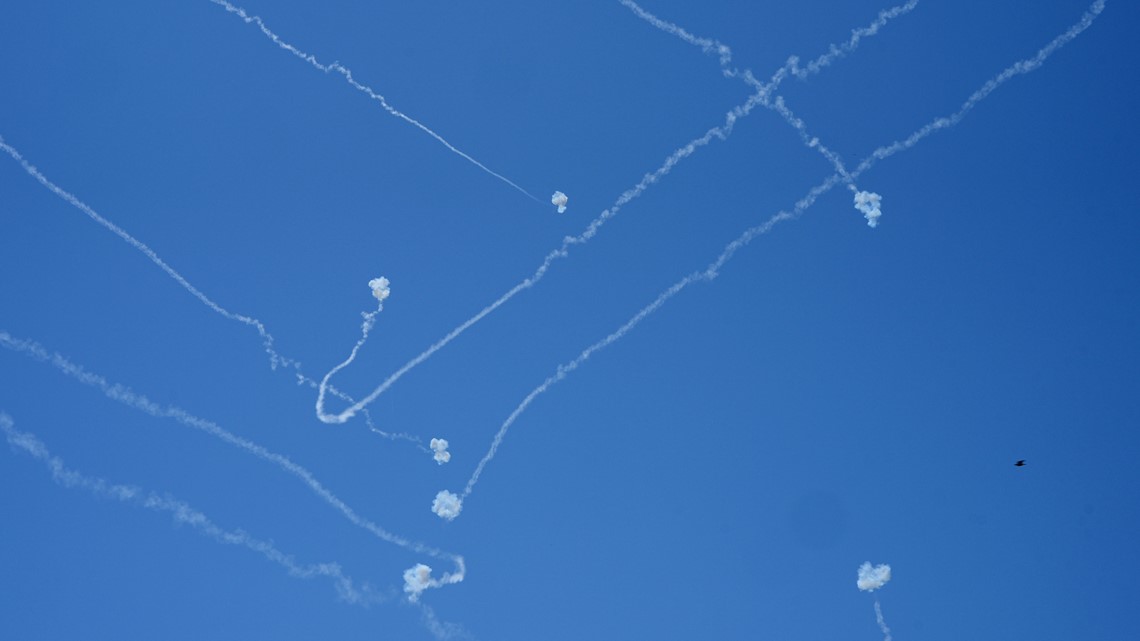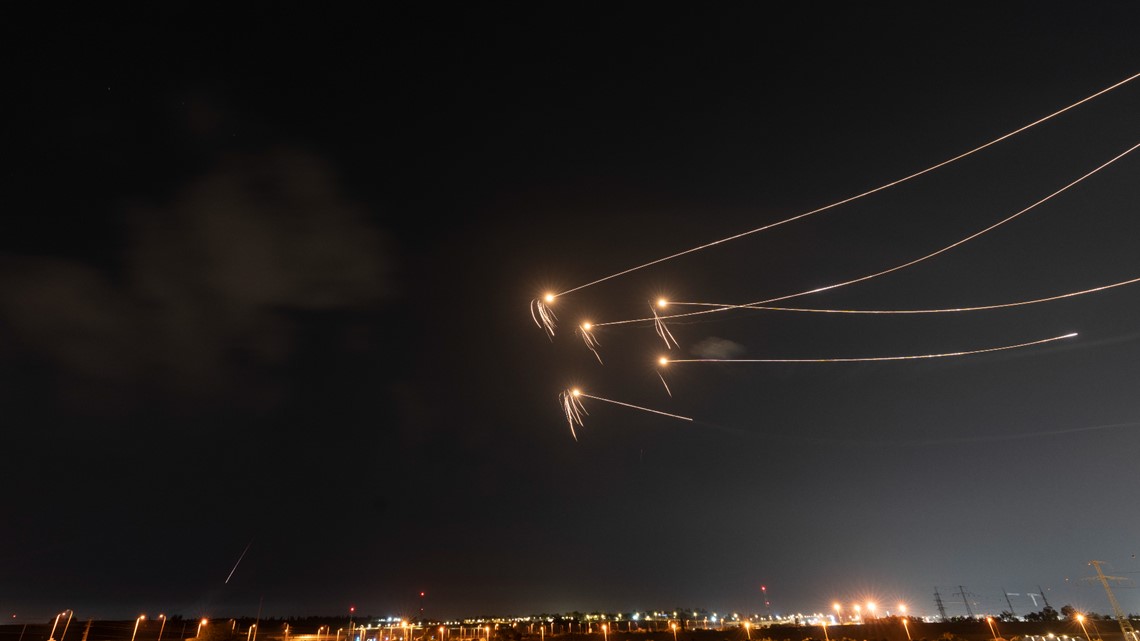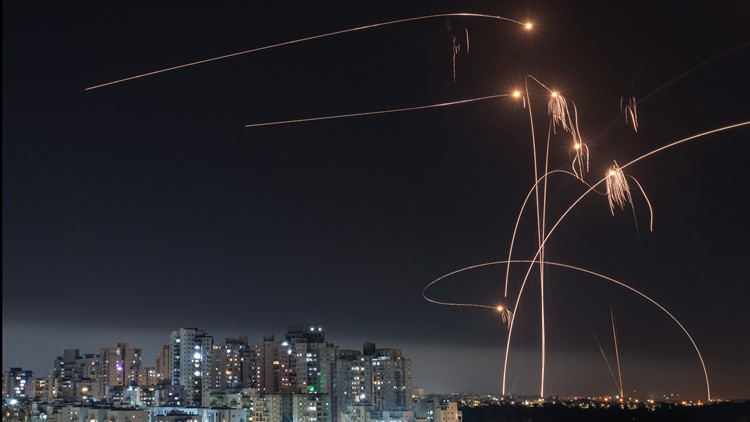INDIANAPOLIS — As the war between Israel and Hamas intensifies, a coalition of bipartisan U.S. representatives has sent an appeal to Congress requesting more support for Israel’s Iron Dome, a land-based missile system designed to intercept rockets and mortars.
For more than a decade, the Iron Dome has functioned as a first line of defense of sorts for Israel. Overwhelming that system proved key to Hamas' strategy in attacking Israel on October 7, with the Palestinian militant group saying it launched 5,000 rockets in 20 minutes before launching their air, land and sea insurgency.
But how, exactly, does it work?
The Iron Dome is the world’s most-used missile defense system, according to Rafael Advanced Defense Systems, an Israeli defense technology company involved in it’s development.
The Iron Dome is a short-range anti-rocket, anti-mortar, and anti-artillery system. It is made up of 10 mobile batteries that can be deployed across Israel, each made up of three to four launchers carrying dozens of missiles and a sensitive radar.
Those missiles are called Tamir missiles and they are extraordinarily expensive, sometimes costing $20,000 to $100,000 each, according to Air and Space Forces Magazine.
The Iron Dome has three main system: a radar system, control system and launcher system. The radar senses when a rocket is anywhere from 2.5 to 43 miles away, according to Raytheon, a U.S. based defense contractor involved in the system’s development.
A control system then analyzes whether the rocket will hit populated areas. If it determines the missile could possibly hit highly populated areas, the system then instructs the launcher to shoot off the Tamir missile that will destroy the other missile in mid-air. The radars are used to detect incoming ordinance and missiles, the control system calculates the trajectory of the weapons and determines whether an interception is necessary.


Israel first sought funding for the system in 2007, about one year after a conflict broke out between the Lebanon-based militant group Hezbollah. It became fully operational in 2011, with the U.S. granting $200 million to help fund it.
A common misconception is that The Iron Dom was designed to intercept any missile, but that’s not the case, according to Raytheon. Instead, it is a high-cost system, designed to intercept much cheaper rockets and missiles. Israel has been working on another air defense system called David’s Sling, which would be designed to handle missiles across the spectrum, like ballistic missiles.
How effective is it?
Raytheon claims the Iron Dome has destroyed thousands of unguided rockets fired from Gaza and Lebanon into Israel since 2011.
The first missile interception from the Iron Dome came on July 14, 2011, according to the IDF and Raytheon. It reportedly intercepted 400 missiles during an eight-day campaign in the Gaza Strip in 2012, and also made 700 interceptions during the 2014 Gaza War.
In May 2021, Hamas reportedly fired more than 4,300 rockets from Gaza into Israel. The IDF claimed the Iron Dome shot down more than 90% of those rockets.
The Israeli Defense Forces, or IDF, reported the Iron Dome intercepted more than 95% of rockets during an operation last May, in 2023. The Israeli military has been less specific on how many interceptions have been made from Gaza since the most recent war with Hamas on Oct. 7, but reported it “intercepted many”.
When Hamas launched a surprise attack on October 7 from Gaza, with land invasions, amphibious assaults and air drops with motorized gliders, many saw it as a test of the Iron Dome’s capabilities.
The IDF claimed Hamas fired close to 2,500 rockets in the first wave, while Hamas claims it fired 5,000.
What is the U.S.’s role in the Iron Dome?
While Israel developed the Iron Dome, funding from the United States has proved crucial to keeping it in operation, according to a report published by the Congressional Research Service in March 2023.
To date, the United States has $158 billion, current, or non inflation-adjusted, dollars, in bilateral assistance and missile defense funding to Israel. Of that total, nearly $3 billion has gone to Iron Dome batteries, interceptors, co-production costs, and general maintenance.
In March 2014, the U.S. and Israeli governments signed a co-production agreement to enable the manufacture of components of the Iron Dome system in the United States, while also providing the U.S. Missile Defense Agency, or MDA, with full access to what had been proprietary Iron Dome technology.


Then, in 2020, the two companies formed a joint venture incorporated in the United States known as Raytheon Rafael Area Protection Systems (R2S). Tamir interceptors are manufactured at Raytheon’s missiles and defense facility in Tucson, Arizona and elsewhere and then assembled in Israel.
Israel also maintains the ability to manufacture Tamir interceptors within Israel.
The U.S. doesn’t just help fund the upkeep of the Iron Dome, it purchased components of it in 2019 for it’s own defense system.
In a speech Tuesday, Biden announced that the U.S. will send Iron Dome interceptors to Israel to replenish stockpiles that have been depleted in the past four days.
"My team has been in near constant communication with our Israeli partners and partners all across the region and the world from the moment this crisis began," the president said. "We're surging additional military assistance, including ammunition, and interceptors to replenish Iron Dome. We are going to make sure that Israel does not run out of these critical assets to defend its cities and its citizens."
Most recently in 2022, The US House of Representatives voted overwhelmingly, 420-9, to pass the Iron Dome Supplemental Appropriations Act, or HR 5323, which sent an additional $1 billion in funding to the system.
Just eight Democrats, including Indiana representative Andre Carson, and one Republican voted against the passage of that act.



